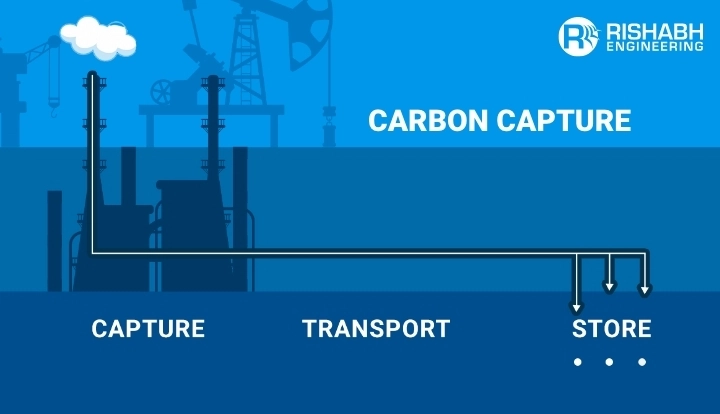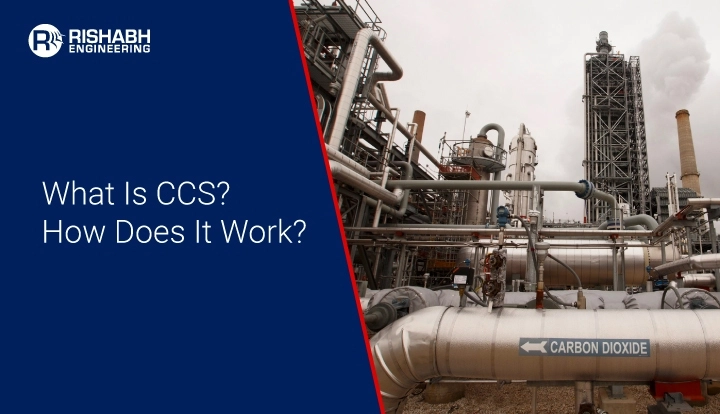
Carbon Capture in the Oil and Gas Industry
In recent years, the urgent need to address climate change has spurred industries worldwide to reconsider their practices and invest in sustainable solutions. Among these, oil and gas sector enterprises are major contributors to carbon emissions. Despite these problems, carbon capture, utilization, and storage (CCUS) technology offer a viable answer.
In this blog, we will discuss the significance, benefits, challenges, and advances of carbon capture in the oil and gas industry and Rishabh Engineering’s role in this revolutionary journey.

Carbon Capture in the Oil and Gas Industry: An Overview
The energy industry paved the way for developing carbon capture systems. CO2 is captured from industrial processes and power generation using various technologies, including post-combustion, pre-combustion, and oxyfuel combustion. The oil and gas industry produces significant amounts of carbon dioxide (CO2), contributing to climate change. Carbon capture reduces emissions by trapping CO2 at its source and keeping it from reaching the atmosphere. Most relevant technologies involve the separation of CO2 from other gases, compression, and transfer to storage locations.
Read this blog if you wish to learn the carbon capture and storage technology concept, its potential benefits, and how multiple discipline engineering companies can work with organizations like you to reduce this impact.
Applications of Carbon Capture in the Oil & Gas Industry
CCUS technologies are increasingly being explored and deployed in the oil and gas industry to mitigate greenhouse gas emissions. Here are several applications of carbon capture in this sector:
- Enhanced Oil Recovery (EOR): Carbon dioxide (CO2) captured from industrial processes or directly from flue gases can be utilized in EOR operations. Injecting CO2 into depleted oil reservoirs can increase oil production by displacing remaining oil and improving its flow characteristics.
- Carbon Capture from Natural Gas Processing: CO2 is often separated from the gas stream during natural gas processing. This captured CO2 can be utilized for various purposes, such as EOR, or stored underground.
- Reducing Flaring and Venting: Instead of releasing CO2 into the atmosphere through flaring or venting, capturing it and either utilizing it or storing it underground can help reduce oil and gas production emissions.
- Carbon Capture from Refinery Operations: Refineries produce significant CO2 emissions during various refining processes. Carbon capture technologies can capture this CO2 and prevent it from being released into the atmosphere.
- Carbon Capture from Power Generation: Many oil and gas facilities include power generation units. Carbon capture technologies can be integrated into these units to capture CO2 emissions from power generation processes.
- Carbon Capture from Hydrogen Production: Hydrogen is essential in various refining and chemical processes within the oil and gas industry. CO2 is often produced as a byproduct during hydrogen production. Carbon capture can be employed to capture this CO2.
- Carbon Capture from Flue Gas: CO2 can be captured directly from the flue gases of power plants, refineries, and other industrial facilities associated with the oil and gas sector.
- Hydrocarbon Extraction and Purification: Carbon capture technologies can be utilized in processes like natural gas purification to capture CO2 emissions.
Benefits Of Carbon Capture for the Oil and Gas Industry
- Emissions Reduction: The primary benefit of carbon capture is its ability to significantly reduce CO2 emissions from industrial activities, helping companies meet emission targets and regulatory requirements.
- Climate Change Mitigation: By capturing and storing CO2, the oil and gas industry can contribute to global efforts to mitigate climate change, transitioning towards a low-carbon future.
- Resource Optimization: Carbon capture technology allows for the extraction of additional oil and gas reserves through enhanced oil recovery (EOR) techniques, maximizing resource utilization while reducing emissions.
- Technology Innovation: Investment in carbon capture drives technological innovation, leading to the development of more efficient and cost-effective solutions that can be applied across various industries.
- Economic Opportunities: Implementing carbon capture projects can create new economic opportunities, such as job creation, infrastructure development, and fostering a market for carbon capture and storage services.
Challenges Of CCS In Oil And Gas
- Costs: One of the primary challenges is the high cost associated with implementing carbon capture technologies, including capital investment, operational expenses, and infrastructure development.
- Energy Requirements: Carbon capture processes often require significant energy, which may offset the environmental benefits and increase operational costs.
- Storage Capacity: Identifying suitable sites for CO2 storage and ensuring long-term stability and containment poses logistical and technical challenges.
- Regulatory Framework: Uncertainty surrounding regulatory frameworks and policies related to carbon capture can hinder investment and project development.
- Public Perception: Public perception and acceptance of carbon capture technologies, including concerns about safety, environmental impact, and long-term efficacy, remain significant challenges.
- Scale-Up and Deployment: Scaling up carbon capture technologies to industrial levels and deploying them across diverse operational environments requires extensive research, testing, and collaboration.
Components of CCS In the Oil And Gas Industry
Carbon capture technologies are crucial in mitigating greenhouse gas emissions in the oil and gas industry. Here are some common components of carbon capture utilized in this sector:
- Pre-combustion Capture: This method involves capturing carbon dioxide (CO2) before it is released during combustion. Pre-combustion capture often occurs in facilities such as refineries and natural gas processing plants in the oil and gas industry. One common technique is steam methane reforming, where CO2 is captured during natural gas conversion into hydrogen.
- Post-combustion Capture: This method involves capturing CO2 after combustion has occurred. It is typically applied to power plants and other facilities where fossil fuels are burned. Post-combustion capture technologies use solvents or other absorbents to separate CO2 from flue gases.
- Oxy-fuel Combustion: In oxy-fuel combustion, fossil fuels are burned in an environment enriched with oxygen instead of air. This results in a flue gas stream primarily composed of CO2 and water vapor, simplifying carbon capture.
- Membrane Separation: Membrane technology passes flue gas through a membrane that selectively allows CO2 to pass through while trapping other gases. This method is particularly useful for capturing CO2 from sources with lower concentrations, such as natural gas processing.
- Adsorption: Adsorption technologies use solid materials known as adsorbents to capture CO2 from flue gases. These adsorbents have a high affinity for CO2 molecules, allowing them to capture and release CO2 for storage or other applications selectively.
- Compression and Transportation: Once CO2 is captured, it must be compressed to a dense state for transportation and storage. Compression facilities and pipelines are essential components of carbon capture infrastructure in the oil and gas industry.
- Injection and Storage: Captured CO2 is often injected into geological formations for long-term storage, a process known as carbon capture and storage (CCS). Common storage sites include depleted oil and gas reservoirs, saline aquifers, and deep geological formations.
Carbon Sequestration in Oil Fields
One of the innovative approaches to carbon capture within the oil and gas industry is carbon sequestration in depleted oil fields. This involves injecting captured CO2 into geological formations, such as depleted oil and gas reservoirs, for long-term storage. Not only does this mitigate CO2 emissions, but it also enhances oil recovery through enhanced oil recovery (EOR) techniques, maximizing the economic viability of carbon capture projects.
How Rishabh Engineering Can Help?
Rishabh Engineering, a prominent multi-discipline engineering services partner, realizes how essential it is to enhance carbon capture activities in the oil and gas industry. Our team leverages its engineering design skills to provide comprehensive services targeted to the specific needs of carbon capture projects.
We offer comprehensive solutions for carbon capture projects, from conceptual design to full engineering and construction support. Its diverse team of engineers and designers uses cutting-edge technology and industry best practices to ensure the effective completion of carbon capture projects while complying with strict safety and environmental regulations. Furthermore, Rishabh Engineering specializes in the design of CO2 transportation and injection infrastructure, which are critical components of CCU in the oil and gas industry.
Final Words
Finally, carbon capture has enormous potential for reducing CO2 emissions in the oil and gas industry, paving the way for long-term sustainability. Despite the technological developments, industry players’ dedication is preparing the way for broad CCS implementation. Companies such as Rishabh Engineering would play an important part in pushing this shift by providing expertise and solutions to support the deployment of carbon capture projects, propelling the sector toward a greener future.
Ready to Embrace Carbon Capture Technology for Oil and Gas Operations?
Our team can help from concept to execution, driving sustainability and operational excellence.

